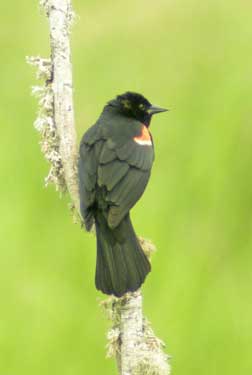 |
Previous Issues |
| Cedar Mill Community Website |
|
| Search the Cedar Mill News: | About The Cedar Mill News |
|
|||||||
| Volume 8, Issue 5 | May 2010 |
||||||
The birds of Cedar Mill
|
 |
A male Red-winged blackbird. Photo by Jeff Young |
On the opposite end of the brightly colored spectrum we have the many plain black and brown birds—which may account for why people new to birding might think this hobby is uninteresting or difficult. In birding books brown sparrows—which can be difficult to distinguish from each other—are often collectively referred to as “little brown jobs” or LBJs.
In Cedar Mill, we have only a few “black birds.” For example, there are the ubiquitous European Starlings (which many biologists call “the flying rat” due to their tendency to be in huge flocks which create a lot of bird waste wherever they happen to go). Holly trees, grapes and other crops may be damaged by the waste they leave behind while roosting. They also eat other birds’ young and are said to be responsible for the disappearance in the Tualatin Valley of the bluebirds, which used to be prominent in this area before the 1960s when the Starling population exploded. On the other hand, like the American Robin, Starlings do have a useful function—notice them hunting for harmful Crane Fly larvae in your lawn.
Other than Starlings we have a few other mostly black birds. For example, Turkey Vultures may be recognized soaring high overhead with a characteristic shallow V shape, or dihedral, in wing posture. You may also notice they tend to rock and tilt unsteadily in the upper air currents, creating a very uneven flying pattern. Compare Hawks and Eagles which hold their wings in a flatter posture when soaring. Turkey Vultures are migratory; we see them generally in the spring and summer.
 |
female Red-winged blackbird. Photo by Jeff Young |
Another black bird is the Red-winged Blackbird, common in our Cedar Mill wetland areas. The male is notable for the red and yellow epaulettes on the shoulders of their wings. The females of these birds are not black but a mottled and striped brown, which is often confusing for new birders who wonder what those brown striped birds were at their feeders!
We also have Brewer’s Blackbirds, which are smaller than Starlings, mostly black but their eye is whitish to yellow. Our final black bird is the Brown-headed Cowbird, which is migratory and not found year round here. These are smaller than the Brewers, have a stouter beak but the males have a brown head. The females, like the female red winged, are mostly a dull brown. These birds are “famous” in the birding world for laying eggs in other bird’s nests so that the other birds raise their young. So if you are truly lucky you might see a bunch of baby robins with a very funny looking “sibling” hanging around which the robin parents are also rearing—the cowbird intruder “egg” that hatched with the robin eggs! Interesting reproductive strategy!!
Crows and Ravens are another group of blackbirds that we will review in the future. And eventually we’ll review the variety of other little brown jobs in Cedar Mill. On rare occasions I have seen a Yellow-headed Blackbird in a local marsh, but usually those are found further east—so keep your eyes open for these less common Blackbirds. Not all black birds are the same!
Lauretta Young gives custom bird tours in Cedar Mill and beyond, www.portlandbirdwatching.com
Published monthly by Cedar Mill Advertising & Design
Publisher/Editor:Virginia Bruce
503-629-5799
PO Box 91061
Portland, Oregon 97291